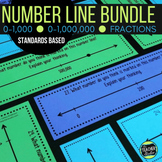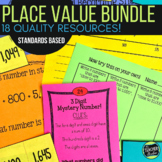Number Line Activities to Build Number Sense and Place Value to 1,000
- PDF
What educators are saying
Also included in
- Using number lines to develop a solid understanding of number sense and place value is absolutely critical as we move our students forward in their mathematical thinking. So many number line activities do not promote deep thinking. These do!We often expose students to numbers in a variety of ways…Price $15.00Original Price $21.00Save $6.00
- This place value bundle includes 18 quality place value activities that can be used successfully with grades 2-5. This may seem like a big grade level range, but—as you know—each grade comes with students who need work both above and below the place value standards assigned to them. The resources arPrice $39.00Original Price $74.25Save $35.25
Description
Why use number line activities when teaching place value? A solid understanding of number sense and place value are absolutely critical as we move our students forward in their mathematical thinking.
One area that is often overlooked is the building of understanding of how numbers relate to each other and how they compare to other numbers.
We often students to numbers in a variety of ways…using manipulatives, using 100’s charts, and so on but forget to help them make the connection to the actual "numbers". This is where number lines have so much power.
For example…students may have a solid understanding of what “10” is and how to model it—but they don’t always realize what “10” means compared to other numbers…that 10 is half of 20…and double 5…and closer to 0 than to 100 and so on! In my attempt to really help my students understand place value AND develop their mathematical practices,
I have developed these resources and share them with you now! THIS edition focuses on numbers through ONE THOUSAND.
What is included?
This resource has a number of different elements to help you tackle place value--including 8 pages of information, teaching tips, and photos of the resource in action!
- It includes 65 ready-to-copy, low ink math journal problems (5 per page) that ask students to either identify a mark on a number line or to make a mark at a certain point on a number line. These are NOT meant to be exact answers—but for students to use their number sense to come up with reasonable solutions. What is CRITICAL is the second part—”Explain your thinking!”
- Whether students work together or alone, the problems ask them to defend their solutions. There are problems at a variety of levels…you will notice that they start easier and get more sophisticated—including a set of pages where the number lines do not start at 0. Look through and see which problems are the right level of challenge for your class—and consider differentiating by giving different groups different problems.
- Also included is a set of 12 pages that can be used as either homework or assessments! Students are asked to do the same types of problems as used in math journals, but are asked to work on them independently. The pages increase in difficulty as their number increases.
- A simple rubric to help you assess how well your students are able to “Construct viable arguments” and a class checklist to record progress.
NOTE: This is a challenging resource geared toward helping grade 3-5 teachers "raise the rigor" of their math instruction. Differentiation tips are included!
================================================
Looking for all my number line resources?
Number Lines with Fractions and Decimals
Number Line Resource BUNDLE of 3 resources (Does not include the number lines to 120 resource)
================================================
All rights reserved by ©The Teacher Studio. Purchase of this resource entitles the purchaser the right to reproduce the pages in limited quantities for single classroom use only. Duplication for an entire school, an entire school system, or commercial purposes is strictly forbidden without written permission from the author at fourthgradestudio@gmail.com. Additional licenses are available at a reduced price.







